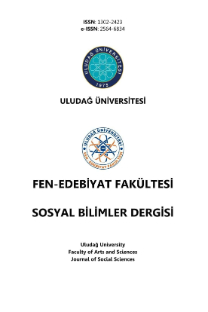AKIŞKAN ZAMANIN CİSİMLEŞEN DENEYİM ALANI OLARAK BEDEN ÜZERİNE SOSYOLOJİK BİR TARTIŞMA
A Sociological Argument on the Body as an Area of Embodied Experience of Liquid Time
___
- Adam, Barbara (1990). Time and Social Theory. Cambridge: Polity Press.
- Azuma, Ronald T. (1997). “A Survey of Augmented Reality”. Presence, C. 6, S. 4, s. 355-385.
- Bauman, Zygmunt (2018). Akışkan Modernite. İstanbul: Can Yayınları.
- Biocca, Frank ve Mark R. Levy (1995). “Virtual Reality as a Communication System”. Communication in the Age of Virtual Reality, Ed: Frank Biocca ve Mark R. Levy, Hove: Lawrence Erlbaum Associates Publishers, s. 15-33.
- Boyne, Roy (2005). “Citation and Subjectivity: Towards a Return of the Embodied Will”. Body Modification, Ed: Mike Featherstone, London: Sage Publications, s. 209-225.
- Coleman, Roy (2005). “Surveillance in the city: Primary definition and urban spatial order”. Crime Media Culture, C. 1, S. 2, s. 131-148.
- Elias, Norbert. (2000). Zaman Üzerine. İstanbul: Ayrıntı Yayınları.
- Featherstone, Mike (1999). “The Body in Cosumer Culture”. The Body: Social Process and Cultural Theory, Ed: Mike Featherstone vd., London: Sage Publications, s. 170-197.
- Featherstone, Mike ve Mike Hepworth (1999). “The Mask of Ageing and the Postmodern Life Course”. The Body: Social Process and Cultural Theory, Ed: Mike Featherstone vd., London: Sage Publications, s. 371-390.
- Foucault, Michel (2006). Hapishanenin Doğuşu. Ankara: İmge Kitabevi.
- Giddens, Anthony (1994). Modernliğin Sonuçları. İstanbul: Ayrıntı Yayınları.
- Giddens, Anthony (2014). Modernite ve Bireysel - Kimlik: Geç Modern Çağda Benlik ve Toplum. İstanbul: Say Yayınları.
- Henderson, Gretchen E. (2016). Çirkinliğin Kültürel Tarihi. İstanbul: Sel Yayıncılık.
- Kaleci, Devkan vd. (2017). “Üç Boyutlu Sanal Gerçeklik Ortamlarındaki Deneyimlere İlişkin Kullanıcı Görüşleri”. Türkiye Sosyal Araştırmalar Dergisi, Aralık, s. 669-689.
- Kim, Jiyeon ve Sandra Forsythe (2008). “Adoption of Virtual Try-on Techonology for Online Apparel Shopping”. Journal of Interactive Marketting, C. 22, S. 2, s. 45-59.
- Lyng, Stephen (1990). “Edgework: A Social Psychological Analysi of Voluntary Risk Taking”. American Journal of Sociology, C. 95, S. 4, s. 851-886.
- Mead, George Herbert (1929). “The Nature of the Past”. Essays in Honor of John Dewey, Ed: John Coss, New York: Henry Holt & Co, s. 235-242.
- Murray, Craig D. ve Judith Sixsmith (1999). “The Corporeal Body in Virtual Reality”. Body, Self, and Technology, C. 27, S. 3, s. 315-343.
- Rey, P. J. (2012). “Alienation, Exploitation, and Social Media”. American Behavioral Scientist, C. 56, S. 4, s. 399-420.
- Serino, Silvia vd. (2018). “From Avatars to Body Swapping: The Use of Virtual Reality for Assessing and Treating Body‐Size Distortion in İndividuals with Anorexia”. Journal of Clinical Psychology, C. 75, S. 2, s. 313-322.
- Sohn, A. M. (2006). “Cinsiyetli Beden”. Bedenin Tarihi 3, Ed: Alain Corbin vd., İstanbul: Yapı Kredi Yayınları, s. 75-105.
- Timurturkan, Meral ve Gönül Demez (2018). “Bir Toplumsal İktidar Alanı Olarak Beden ve “Yaşlanan Bedenin” Yeniden İnşası”. Mehmet Akif Ersoy Üniversitesi İktisadi ve İdari Bilimler Fakültesi Dergisi, C. 5, S. 2, s. 441-456.
- Turner, Bryan (1996). The Body & Society. London: Sage Publications. Wishnitzer, Avner (2010). “‘Our Time’: On The Durability of The Alaturka Hour System in The Late Ottoman Empire”. International Journal of Turkish Studies, C. 16 S. 1 & 2, s. 47-69.
- Yim, Mark Yi-Cheon ve Sun-Young Park (2019). “‘I am not satisfied with my body, so I like augmented reality (AR)’: Consumer responses to AR-based product presentations”. Journal of Business Research, C. 100, s. 581-589.
- https://www.theguardian.com/technology/2019/jun/23/what-do-we-doabout-deepfake-video-ai-facebook (Erişim Tarihi: 01.08. 2019)
- ISSN: 1302-2423
- Yayın Aralığı: 2
- Başlangıç: 1999
- Yayıncı: Bursa Uludağ Üniversitesi
Aydınlanma Gelenekleri ve Politik Yansımaları
DEMOKRASİLERDE DARBE GEÇİRMEZLİĞE YAKINDAN BAKMAK: SİVİL-ASKER İLİŞKİLERİNDE İSPANYA ÖRNEĞİ
FERMAN VE BERATLARA GÖRE 1603-1604 TARİHİNDE BURSA VE KİTE KAZALARININ DEVLET MERKEZİ İLE İLİŞKİLERİ
TÜRKİYE’DE ULUSAL KİMLİK İNŞASI VE SİYASİ PARTİ KİMLİKLERİ
DİVAN-I HÜMAYUN KARARLARINDA BURSA VAKIFLARI (1553-1649)
ZAMİR /N/’SİNİN TÜRKÇEDEKİ FONEMORFOLOJİK GELİŞİMİ
OSMANLI AİLE YAPISININ MİLLET SİSTEMİ İÇİNDEKİ KONUMU
EMEKLİLİK FON YÖNETİCİLERİNİN YATIRIM İNANÇLARI ÜZERİNE YAZIN TARAMASI
Dilek ÖNKAL, Magnus JANSSON, FİLİZ ERYILMAZ, Doron SONSINO
A. ADNAN SAYGUN’UN OP.31 “PARTİTA” ADLI SOLO VİYOLONSEL (IV. BÖLÜM) ESERİNİN GEOMETRİK MODELLEMESİ
